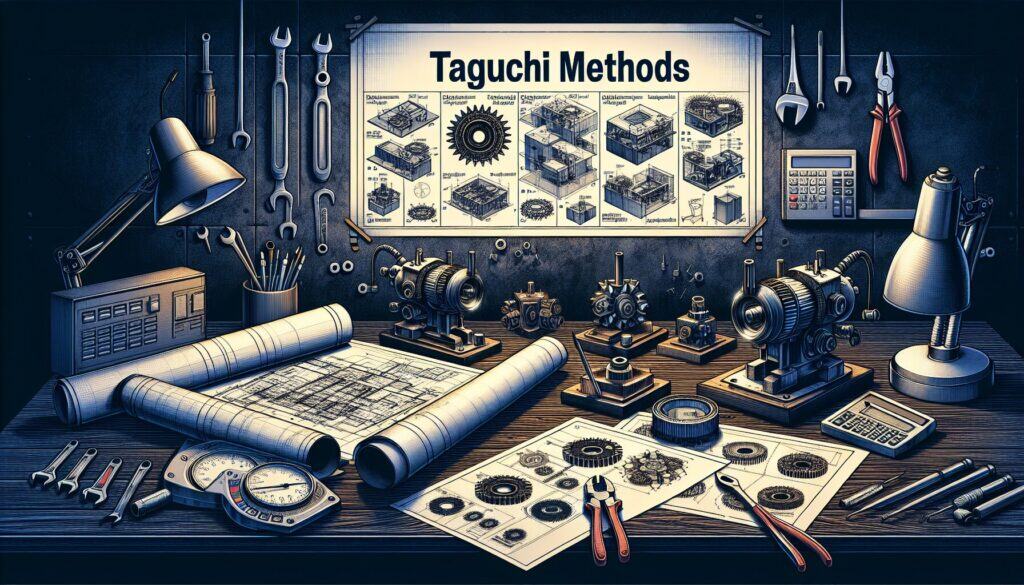An engineering methodology focused on improving quality and reducing costs by designing products and processes that are robust to uncontrollable variations (noise factors).
- المنهجيات: الهندسة, الجودة
Taguchi Methods (Robust Design)

Taguchi Methods (Robust Design)
- التحسين المستمر, التصميم من أجل التصنيع (DfM), التصميم لسداسية سيجما (DfSS), تحسين التصميم, التصنيع اللين, تحسين العمليات, ضمان الجودة, مراقبة الجودة, التحكم في العمليات الإحصائية (SPC)
الهدف:
كيفية استخدامه:
- Employs statistical experimental design (e.g., orthogonal arrays) to identify optimal design parameters that make the product or process insensitive to variations in manufacturing, environment, and usage, thereby minimizing performance variation.
الايجابيات
- Leads to higher quality products with lower lifetime costs; reduces the need for tight manufacturing tolerances; focuses on achieving target performance consistently.
سلبيات
- Can be complex to implement and requires statistical knowledge; experiments can be time-consuming and costly if not planned efficiently; may oversimplify complex interactions in some cases.
الفئات:
- الهندسة, تصنيع, الجودة
الأفضل لـ
- Designing products and processes that are minimally affected by uncontrollable noise factors, leading to consistent performance.
Taguchi Methods, particularly in robust design, find significant applications across various industries such as automotive, electronics, consumer products, and manufacturing, where the goal is to improve product resilience against fluctuations in material properties, environmental conditions, or user interactions. This methodology is especially relevant during the product development phase, where initial prototypes are tested using statistical techniques to analyze how different design parameters affect performance. Teams composed of design engineers, quality assurance professionals, and data analysts often collaborate in this process, ensuring that multiple perspectives contribute to a well-rounded approach. For example, in the automotive sector, Taguchi Methods can be utilized to assess aspects such as suspension system performance under various road conditions, allowing manufacturers to design vehicles that provide a smooth ride regardless of external disturbances. The use of orthogonal arrays in experiments allows teams to efficiently study many factors simultaneously, significantly speeding up the optimization process. Furthermore, implementing Taguchi Techniques minimizes the requirement for extensive physical testing since statistical results can often predict how changes will affect product performance, resulting in reduced development time and costs. By integrating customer feedback early in the design process, companies are better positioned to identify and address specific needs, leading to high satisfaction rates and lower warranty claims once the product is launched. These benefits contribute not only to superior product quality but also to long-term savings associated with maintenance and customer service, as robust designs are more likely to remain reliable over their lifecycle.
الخطوات الرئيسية لهذه المنهجية
- Identify the target quality characteristics for the product or process.
- Determine the noise factors affecting performance.
- Select appropriate orthogonal arrays for experimental design.
- Conduct experiments to evaluate the effects of design parameters on performance.
- Analyze experimental results to identify optimal levels of design parameters.
- Conduct confirmation experiments to validate optimal settings.
- Implement improvements based on findings.
- Monitor performance to ensure consistency and robustness post-implementation.
نصائح للمحترفين
- Utilize advanced Taguchi orthogonal arrays to systematically explore multi-factor interactions and identify robust settings that can mitigate the impact of noise.
- Integrate response surface methodologies post-Taguchi analysis to refine the optimal design parameters identified, ensuring enhanced performance stability across varying conditions.
- Conduct regular sensitivity analyses on the identified optimal settings to anticipate how changes in noise factors could impact performance, enabling proactive design adjustments.
لقراءة عدة منهجيات ومقارنتها, نوصي باستخدام
> مستودع المنهجيات الشامل <
مع أكثر من 400 منهجية أخرى.
نرحب بتعليقاتكم على هذه المنهجية أو المعلومات الإضافية على قسم التعليقات أدناه ↓، وكذلك أي أفكار أو روابط متعلقة بالهندسة.
السياق التاريخي
1949
1950
1950
1960
1960
1960
1960
1940
1950
1950
1958
1960
1960
1960
1960
(إذا كان التاريخ غير معروف أو غير ذي صلة، على سبيل المثال "ميكانيكا الموائع"، يتم تقديم تقدير تقريبي لظهوره الملحوظ)















منشورات ذات صلة
جدول الإنتاج الرئيسي (MPS)
التخصيص الشامل
قمع التسويق
التدقيق التسويقي
مؤشر MAPO (حركة ومساعدة مرضى المستشفيات)
تخطيط موارد التصنيع (MRP II)